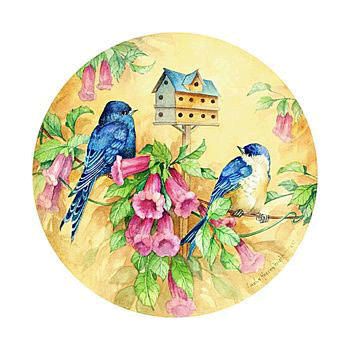Please Help Pets with a Small Donation of One Dollar
The Lovely little Martin Family of Birds
Presented by: the Birds @ Pet Care Tips
The Martin can be any of several Swallows that belong to the
family Hirundinidae. In America the name Martin refers to
the Purple Martin.
It has at least four tropical relatives that are also called
Martins.
The Sand Martin or Bank Swallow is five inches long and
brown and white in color. It breeds all over the Northern
Hemisphere and prefers to make its nests in burrows in
sandbanks.
The House Martin is blue and black with a white rump. It is
common in Europe.
The African River Martin is seen on the Congo River and is
black with red eyes and bill.
The Kingbird, also called the Bee-Martin or Bee Bird, is
commonly mistaken to be a Martin, though it is not.
The Purple Martin is a large swallow that is of a medium
size and is a very attractive songbird. It has a large head,
thick chest and broad, pointed, swept back wings. Purple
Martins are around eight inches long; the largest of the
American swallows.
The Purple Martin naturally nests in cavities, and is a
popular resident of backyard birdhouses. In eastern North
America it almost always nests in human-provided nest boxes
or birdhouses and has done so for more than one hundred
years. Like other Swallows, Purple Martins will nest in
colonies, so in rural America there are often large condo-
birdhouses erected that contain multiple nest holes and may
house from five to one hundred nesting Martin families at
once.
The male Purple Martin is a glossy blue-black on top and on
bottom. The female Purple Martin is bluish black on the back
and a dingy grayish brown on the chest. The belly is an even
paler dirty gray. She also has a gray collar around the back
of the neck.
The young Purple Martin is similar to the adult female in
coloring but more drab and with less blue on the back. The
under parts of the bird are a dirty white. The wing and tail
feathers are brown in color. First winter birds of both
sexes resemble the adult female in coloring. The yearling
male Purple Martin has a whiter belly with some dark blue
feathers here and there on the chest.
Purple Martins have been welcomed around human settlements
because of their diet of insects, including mosquitoes, and
because they are protective of their nesting territories
against predators, chasing away raptors and crows, and in
the process protecting other songbirds and chickens.
The song of a martin is a distinctive, low pitched liquid
rolling twitter.
Purple Martins build their nests in cavities of trees,
or holes in cliffs, anywhere from 3 to 30 feet high.
Their nests are made from leaves, grass, straw and twigs.
The eggs are white and unmarked.
Purple Martins feed on a variety of flying insects, flies,
bees, beetles, flying ants and moths.
Many folks build Purple Martin houses which are generally
well liked by the birds. They prefer the wooden condominium
type houses. White is the choice of color for these houses,
as white keeps the house cooler and is attractive to
the birds. The best height is from 15 to 20 in the air.
Picture of Purple Martins

See Also:
Bomb Island
Swallows
Listing of Perching Birds